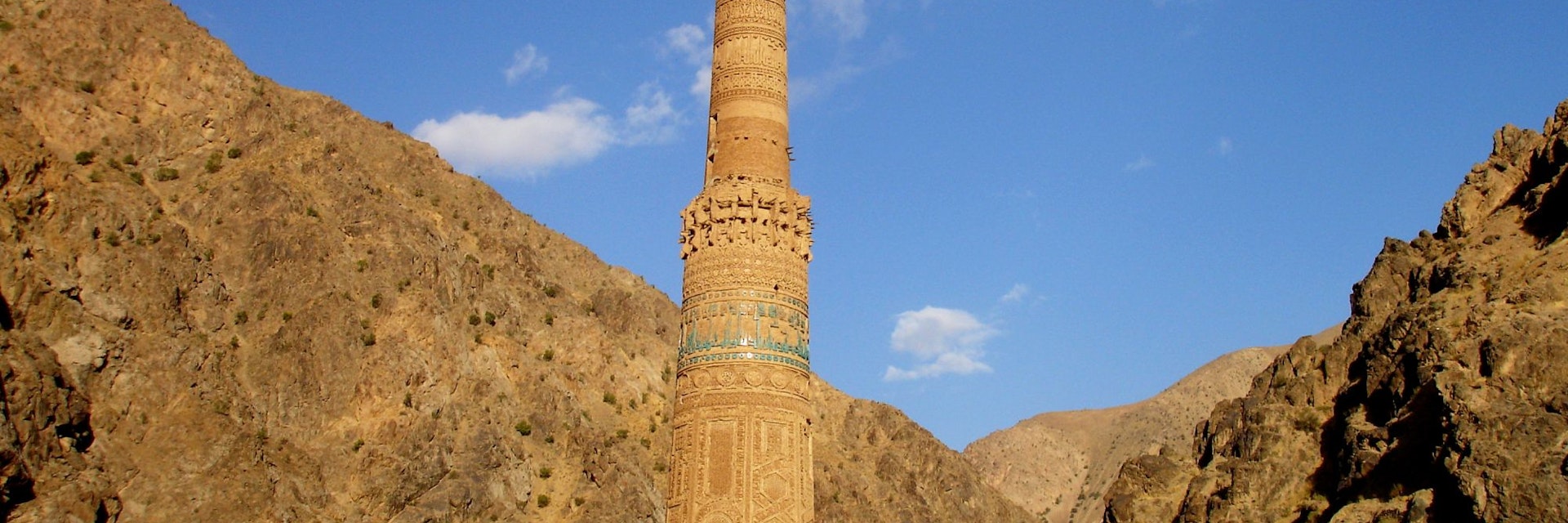Reaching a dizzying height of 65m, the Minaret of Jam stands as a lonely sentinel at the confluence of the Hari Rud and Jam Rud rivers, the greatest surviving monument of the medieval Ghorid empire. Forgotten by the outside world until the mid-20th century, it remains a holy grail for many travellers to Afghanistan. The first view of the minaret as it looms suddenly and unexpectedly from the folds of the mountains is worth all the rough roads it takes to get there.
The minaret was built in 1194 for Sultan Ghiyasuddin, the grandest of the Ghorid rulers, and marks the highpoint of their fired-brick architecture (Ghiyasuddin also commissioned Herat’s Friday Mosque at this time). Three tapering cylindrical storeys rise from an octagonal base, the whole completely covered in intricate café-au-lait brick decoration. Interlocking chains, polygons and medallions wind delicately around the shaft, interspersed with text from the Quran.
At the neck of the first section, a band of Kufic text spells out Ghiyasuddin’s name in glazed turquoise, the only colour on the minaret. Above this are spars from the original wooden scaffold and brick buttresses that would originally have supported a balcony. The second and third shafts are more restrained in their decoration, surmounted by a final lantern gallery with pinched and pointed arches. Few muezzins have ever had such a stage for their call to prayer.
At the time of its construction, the minaret was the tallest in the world and, until the 20th century, only the Qutb Minar in Delhi was taller. For many years, archaeologists were mystified as to its purpose. Its isolated location begs the same question from every visitor: why here? Given the lack of associated buildings, it was assumed by many to be part of a concurrent Central Asian trend for raising single massive towers as statements of political power, possibly marking victory over a pagan populace. Jam is now recognised to be the site of the lost city of Firuzkoh, the Ghorids’ capital destroyed by the Mongols.
It’s possible to climb the minaret and the views are amazing. A ladder allows you to crawl through a narrow entrance hole to the interior. There are two staircases, winding around each other like a DNA double-helix. Care should be taken on the narrow steps and a torch isn’t a bad idea. The stairs end in an open chamber, from where you can look out over the confluence of the Hari-rud and Jam rivers. A second staircase continues from here up to the lantern gallery, although the climb feels more than a little precarious.
In 2002, the Minaret of Jam became Afghanistan’s first Unesco World Heritage site, simultaneously being placed on the list of World Heritage sites in danger. It’s easy to see why. Sat on the confluence of two rivers, erosion of the foundations has been a constant worry, and gabion walls have been built to reinforce the structure. Even so, the minaret still lists at a worrying angle. Illegal looting, which ironically reached its peak after the fall of the Taliban, has also damaged the site, and robber holes can easily be spotted in the area.
